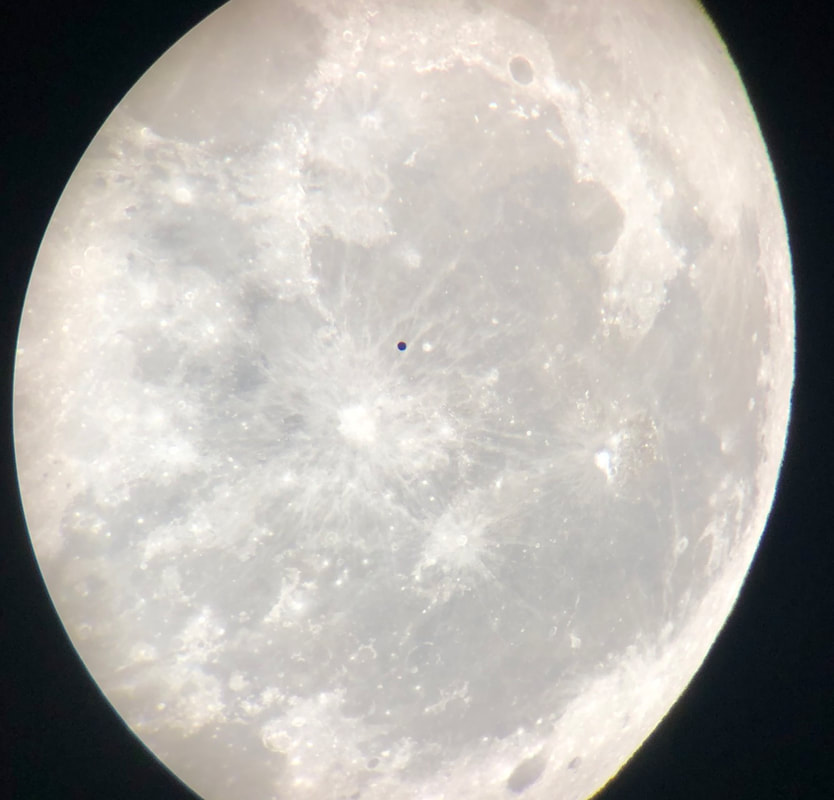|
It may be no surprise, but when I have to use one telescope these days, I take my Takahashi FC-100DC. It's wonderfully lightweight, it's beautifully made - in a way that's really growing on me - and gives views that seem remarkably bright for its aperture. By comparison, the Moon gets noticeably dimmer and yellower when I get past 150x or so in my TV 85; it stays as bright as ever at over 200x in the FC-100DC. At just after 9:00 PM on October 14, while on our observation deck with my Takahashi, I had one of the most bizarre and, for a moment, frightening sightings as an amateur astronomer. As I observed the Moon at around 150x, a perfectly black, sharply defined circle abruptly appeared in front of the white disk. It began to slowly move across the Moon, looking for all the world like a planet transiting in front of the Sun. Then, when the circle reached the edge of the Moon, it stopped and then started moving in the opposite direction across the surface of the Moon. It meandered slowly and smoothly around the lunar disk. When I increased the magnification, the circle got bigger; when I reduced magnification, it got smaller. Rattled, I checked the telescope thoroughly and found it in like-new condition, with no dust or blemishes on the lens. Eventually, I looked away from my eyepiece. When I looked again, the circle was gone. I was flabbergasted. What did I just see? I couldn't wrap my head around it. Bizarrely, I'm just now researching and writing about the history of perceived changes in lunar environments, including those often called "Transient Lunar Phenomena" (TLP). Observers who thought they'd seen a TLP in the past often expressed shock. I felt that too. The only explanation that made a modicum of sense was a balloon, at just the right distance away. But what could explain the seemingly deliberate motion of that little circle? My imagination went wild. I packed up quickly and recounted the sighting to my wife. I wrote a short report on CloudyNights, the popular astronomy forum, and then sent a message to the Central Bureau for Astronomical Telegrams. Within minutes, I received a reply from Michael Rudenko at Harvard. Apparently, I had observed one of Google's stratospheric balloons, deployed for Project Loon: an effort to bring the Internet to underserved regions. Two years ago, another sighting apparently perplexed an observer in Puerto Rico. What a coincidence - and what a reminder of just how many machines we've placed in the atmosphere, in space, and on the edge of space and atmosphere. Just before observing the Moon, I did manage to catch a glimpse of Almaak (Gamma Andromedae), the apparent double star that is really a quadruple star system. I never really got the appeal of double stars, but I'm starting to now. The contrast in colors is beautiful, as is the thought of sunsets on orbiting planets . . . .
Quite a night, overall . . . and quite a telescope.
0 Comments
A few days ago, I learned that Orbital ATK would soon attempt to launch its Cygnus cargoship from Wallops Flight Facility in Virginia to the International Space Station. If the rocket didn't blow up - a very real possibility, since Orbital's last rocket did - the launch would be easily visible from Washington. I walked outside with my telescope to watch what I hoped would be a successful launch. I didn't realize, however, that Orbital had scrubbed the launch. After observing the moon, I walked back inside, disappointed. Orbital rescheduled the launch for tonight, and this time I ventured outside with my 15x70 binoculars. They would probably be more useful for tracking a rocket, anyway. About five minutes after the rocket was supposed to launch, I started to think that there had either been an explosion or another delay. Then, I noticed a bright orange flare rising to the southeast. Nearby, just out of sight, a family started cheering. My binoculars gave me a wonderful view of the flare and its flickering flames. After the rocket climbed high enough, the flare disappeared. A few seconds later, I spotted a yellow light, just above where the flare had been. The first stage had dropped away, I realized, and the smaller engine on the second stage was carrying the Cygnus ship into space. After a little while, the light disappeared. I'd witnessed my first successful rocket launch, and my binoculars helped me feel far closer to the action than I really was.  The Cygnus cargo ship approaches the International Space Station. The Cygnus cargo ship approaches the International Space Station. |
Archives
March 2024
Categories
All
|









 RSS Feed
RSS Feed